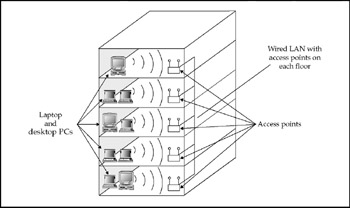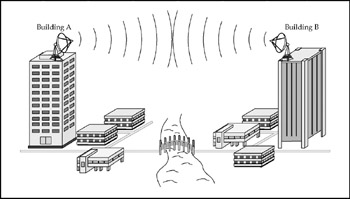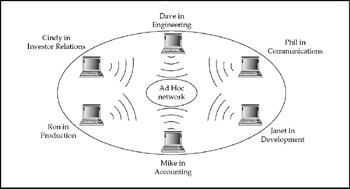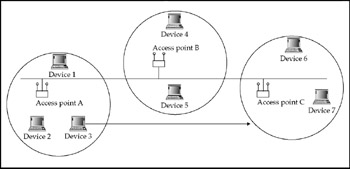WLANS
A WLAN is just what the acronym suggests-a LAN that is accessed without having to be physically tethered to a server, switch, hub, or any other networking device. Using radio frequency (RF) technology, WLANs transmit and receive data out of midair, eliminating the need for conventional, wired connections. WLANs are becoming more and more popular in a number of specialized fields, including health care, retail, manufacturing, warehousing, and academia. These domains have benefited from the productivity gains of using handheld PCs and notebook computers to transmit and receive real-time information with the centralized network. WLANs are gaining recognition as a general-purpose network connectivity solution for a broad range of business users.
In this section, we'll take a closer look at how wireless networking is deployed in a practical manner. Then we'll look at some of the core technologies fueling wireless networks. Finally, we'll gaze into our crystal ball and try to predict where wireless networking is going in the future.
How They Work
Like cordless telephones, WLANs use electromagnetic radio waves to communicate information from one location (your laptop, for instance) to another (an access point), without having to use any physical medium to transfer the message. Figure 8-1 illustrates this.

Figure 8-1: WLANs communicate information like cordless telephones
| Note | Radio waves are often referred to as radio carriers because their function is delivering energy to a remote receiver. The transmitted data is superimposed on the radio carrier so that it can be extracted at the receiving end. This is known as modulation of the carrier by the transmitted information. |
Once data is added onto the radio carrier, the radio signal spills over, occupying more than a single frequency. This happens because the frequency-or bit rate-of the modulating data adds to the carrier.
This may seem to present a problem, especially in environments where several computers will be trying to access the wireless device. In reality, however, multiple carriers function just fine in the same area, as long as the radio waves are transmitted on different frequencies. In order to collect data, a radio receiver tunes in just one specific radio frequency, as shown in Figure 8-2, while ignoring all others.

Figure 8-2: Wireless devices tune out unwanted frequencies and focus on the relevant one
In a WLAN, the device that physically connects to the wired LAN is a transceiver (a combination of a transmitter and receiver) and is commonly called an access point. The access point receives, buffers, and transmits data between the WLAN and the wired network. As shown in Figure 8-3, another way to think about an access point is to consider it as a wireless hub-a single access point can serve hundreds of clients. Depending on the range of the access point, clients can be located within a few feet or up to 1,500 feet away from it. Optimally, the antenna for the access point would be situated high above the floor. However, the antenna could be located anywhere space permits.

Figure 8-3: Access points serve as wireless hubs, connecting one-or many-wireless devices to the LAN
To connect to the access point, client computers use WLAN adapters, which are small PC cards for notebook and palmtop computers, and expansion cards in desktop computers. They can also be integrated within handheld computers and many new notebooks, palmtop, and tablet PCs. These cards have built-in antennas and transceiver components.
Architecture
Wireless LANs can be as simple as two computers talking to each other or as complex as hundreds of computers in one location connecting to computers in a building miles away. Let's take a look at the three basic ways you can build your wireless networks.
Peer-to-Peer
The simplest, most basic wireless network consists of at least two PCs equipped with wireless adapter cards. As shown in Figure 8-4, no access point is needed; whenever these two computers get within range of each other, they form their own independent network. This is called a peer-to-peer network or ad-hoc network. On-demand networks like this are extremely simple to set up and operate. They require no administration or preconfiguration; however, in this case, each computer would only have access to the resources of the other computer, but not to a central server or the Internet.

Figure 8-4: Peer-to-peer, or ad hoc, networks connect individual devices
This type of network is ideal for home networking or small businesses for spontaneous networking.
In-Building
Much like a conventionally wired network, in-building WLAN equipment consists of a PC card, Personal Computer Interface (PCI), and Industry-Standard Architecture (ISA) client adapters, as well as access points.
To extend the range of your WLAN, as shown in Figure 8-5, or to increase functionality, access points can be used in the network's topology and will also function as a bridge to a wired Ethernet network.

Figure 8-5: By using multiple access points, the availability of the LAN can be increased
By applying WLAN technology to desktop systems, an organization is afforded the flexibility that is simply impossible with a conventional LAN. Clients can be deployed in places where running cable is simply impossible. Furthermore, clients can be redeployed anywhere at any time. This makes wireless ideal for temporary workgroups or fast-growing organizations.
Installing an access point can extend the range of a wireless network. It would essentially double the range at which the devices can communicate. Because the access point is connected directly to the wired network, each client has access to the server's resources, as well as to other clients. Like hubs in a wired network, each access point can accommodate several clients-exactly how many depends on how many transmissions are involved and the nature of those transmissions. It's not uncommon for access points to handle up to 50 clients.
| Note | Be aware, however, that more clients connecting to an access point cuts into the amount of traffic an access point can handle. If an access point is handling 40 clients, don't expect it to be as speedy as an access point being used by only 10 clients. |
Repeaters, as shown in Figure 8-6, look and act just like access points, but with one important exception-they are not tethered to the wired network. Repeaters extend the range of the network by relaying signals from a client to an access point or another repeater. Repeaters are necessary because signals weaken the farther they are from their receiving point. If you have clients that are far from the wired network, repeaters can be strung together in order to pass along data from the clients to an access point.

Figure 8-6: Repeaters are simply access points configured to extend the range of a WLAN
Building-to-Building
The ultimate achievement in wireless networking comes when networks are extended between buildings in different cities. By using a wireless bridge, networks located in buildings miles away from each other can be connected into a single network.
When connecting networks between buildings with copper or fiber, there are any number of obstacles that can put the skids on a project. Roads, rivers, and politics can break a project. A wireless bridge makes physical and ideological barriers a nonissue. Transmission through the air in accordance with 802.11 requires no license and no right of way.
For deployments that do not offer a wireless alternative, organizations routinely fall back to WAN technologies. However, leasing a line from a telephone provider presents a number of headaches:
-
Installation is expensive and takes a long time to set up.
-
Monthly fees are expensive for high bandwidth. The additional rub is that by LAN standards, WAN speeds are very low. This is because telephone lines were designed and built for voice, not data.
One can purchase and install a wireless bridge in a single afternoon, and the cost is comparable to a T1 installation charge alone. Even better, there is no monthly charge-once a wireless connection is made, there are no recurring charges. Furthermore, wireless bridges provide bandwidth from a technology rooted in data, not voice.
To make your building-to-building network happen, you need two directional antennas and a clear line of sight between them. Let's suppose you had a WLAN in Building A (the headquarters) and wanted to extend it to a satellite office in Building B, ten miles away in a neighboring city. As shown in Figure 8-7, you could install a directional antenna on the roof of each building, with each antenna targeting the other. Building A's antenna is connected to your main LAN through an access point. The antenna on Building B is similarly connected to an access point to that facility's LAN. This configuration brings the two LANs, located miles apart, together into one, common LAN.

Figure 8-7: Wireless bridges bring two networks-located miles apart-together
Because of their mobility and ease of installation, WLANs have a significant leg up on conventional LANs. They provide networking opportunities that would not be available to wired networks, and are not much more expensive in the long run.
Technologies
There are a number of technologies that make wireless data transmission and receipt possible. Many of them have their roots in cellular telephony, while others have been designed solely with wireless networking in mind.
In this section, we take a closer look at three of the most popular technologies and how they impact your wireless networking needs. These technologies cover short-range data communications, long-range data transfer, and how the Internet can be accessed using cellular phones.
802.11
The core technology that allows WLANs to communicate is the IEEE 802.11 standard. The IEEE 802.11 working group was formed in the early 1990s to develop a global standard for wireless LANs operating in the unlicensed 2.4-GHz frequency band. As we mentioned earlier, the first incarnations of 802.11 supported up to 2 Gbps.
The 802.11 x standard offers different variations on the protocol for different speeds, frequency of operation, and range. The 802.11 x LAN is based on an architecture that is similar to the design of cellular telephone networks. Wireless LANs (WLANs) operate by connecting an AP (access point) to the server, while client computers are fitted with wireless adapters. These adapter cards can be installed in desktop or laptop computers, as well as in other networking devices, including print servers. Many laptops come with wireless capabilities built in.
There are three types of 802.11 x networks germane to our discussion:
-
802.11a Using this specification, devices transmit at 5 GHz and send data up to 54 Mbps. Although the speed is good, the range of 802.11a devices suffers, because it is limited to somewhere around 75 feet in a typical environment.
-
802.11b Using this specification, devices transmit at 2.4 GHz and send data at up to 11 Mbps. This was the first commercially available wireless network. The speed wasn't great, but it made it possible to connect devices without being tethered by Cat 5 cabling. You'll see 802.11b in legacy devices, as it has been supplanted by the speedier 802.11g.
-
802.11g This specification handles data communications at speeds of up to 54 Mbps and utilizes the same frequency as 802.11b devices (2.4 GHz). Because they operate on the same frequency, 802.11g is an easy upgrade path from existing 802.11b deployments.
-
802.11n The latest incarnation of the wireless specification is 802.11n. As of this writing, 802.11n is brand new and Cisco's support of it has been introduced in some of its Linksys products. It features speeds of up to 12 times those of 802.11g with four times the range.
| Note | There are other alphabet soup variations of the 802.11 x standard (802.11c, 802.11d, and so forth, up through 802.11i). However, the rest of these variations really don't have anything to do with the current state of Cisco wireless networking. |
For easier understanding of these three protocols and how they stack up against each other, we've enumerated their similarities and differences in Table 8-1.
| Standard | 802.11a | 802.11b | 802.11g | 802.11n |
|---|---|---|---|---|
| Speed | 54 Mbps | 11 Mbps | 54 Mbps | 540 Mbps |
| Cost | Moderately expensive | Inexpensive | More expensive than 802.11b, but less expensive than 802.11a | Most expensive option, especially as new products come onto the market |
| Frequency | 5 GHz-This band is uncrowded and can coexist with 802.11b and g networks | 2.4 GHz-This band is crowded and interference might occur with cordless telephones, microwave ovens, and other devices | 2.4 GHz-This band is crowded and interference might occur with cordless telephones, microwave ovens, and other devices | 2.4 GHz-This band is crowded and interference might occur with cordless telephones, microwave ovens, and other devices |
| Range | 25 to 75 feet indoors | 100 to 150 feet indoors | 100 to 150 feet indoors | 160 feet indoors |
| Radio Compatibility | Incompatible with 802.11b and g networks | Most prevalent deployment | Interoperates with 802.11b, but incompatible with 802.11a | Interoperable with 802.11b and g networks, making it a good fit to augment the most prevalent existing networks |
There are two different ways to configure an 802.11 WLAN:
-
Ad hoc
-
Infrastructure
Let's take a closer look at each of these types of WLAN infrastructure.
Ad hoc In the ad-hoc network, computers are brought together to form a makeshift network, like a peer-to-peer network. As Figure 8-8 shows, there is no hierarchical structure to the network and no need for an access point. Everything is mobile and every node is able to communicate with every other node. A good example of how this would appear in the real world is to think of a meeting where everyone brought his or her own laptop.

Figure 8-8: The 802.11 x standard for wireless networking makes an ad hoc network around a conference table possible
Infrastructure The second type of connection, shown in Figure 8-9, comes more closely in line with a conventional LAN topology. This design uses fixed network access points with which mobile nodes can communicate. The access points can be placed within range of each other to expand the range of the network.

Figure 8-9: In this example, the floor plan of a company's first floor shows how APs can be deployed
802.11 Design
802.11 was developed with three needs in mind:
-
The need for a media access control (MAC) and physical layer specification for wireless connectivity for portable fixes and roaming stations
-
The need for wireless connectivity to automatic machinery, equipment, or stations that require fast connectivity
-
The need to offer a global standard
It's the third requirement that led the IEEE to embrace 2.4 GHz as the preferred frequency. It is an unlicensed frequency band that is reserved for industrial, scientific, and medical use on a global basis.
The Mechanics The 802.11 LAN is based on an architecture that is similar to the design of cellular telephone networks. By using a comparable network design, wireless networks can reap the same benefits as cellular, while providing high data rates.
-
Cells and sets An 802.11 LAN is subdivided into cells, and each cell is referred to as a basic service set (BSS), which is the coverage area of an AP. Each BSS is controlled by an access point. But, because a single access point may not be capable of fulfilling the network's wireless needs, several access points can be connected to a common backbone. When a configuration of several access points is used, this is called a distribution system. No matter how large or small the network, no matter how many nodes are connected, the grouping of wireless equipment is viewed as a single IEEE 802.11 network to upper layers of the OSI Reference Model. In 802.11 terminology, the upper layers of the OSI Reference Model are referred to as an extended service set.
-
The physical layer The 802.11 protocol covers the physical and media access control. But instead of a lone-type of media, 802.11 supports four kinds of media: frequency-hopping spread spectrum, direct-sequence spread spectrum, orthogonal frequency division multiplexing (OFDM), and infrared.
A single MAC layer supports all three physical layers. In addition, the MAC layer provides a link to the upper-layer protocols. These functions include fragmentation, packet retransmission, and acknowledgments.
By basing wireless networking on cellular architecture, wireless devices can join, leave, or roam from cell to cell much like cellular telephones do. The heart of each cell is an AP.
Making the Connection When it comes down to actually connecting to an access point or another computer, there are two methods that are used. The first involves a station joining an existing cell; the second involves the process of moving from one cell to another:
-
Joining an existing cell There are three different times when a wireless device will try to access an existing access point or another wireless device: when the device is powered up, after exiting sleep mode, or when it enters a new area. With each situation, the device needs to obtain synchronization information. The device will locate another device to sync with through either active or passive scanning. But how does a device know that there are other wireless devices with which it can interconnect? With two different methods of scanning:
-
Active Scanning This type of scanning requires the device to attempt to locate an access point that can receive synchronization information from that device. This is accomplished by transmitting probe request frames and waiting for a probe response packet, which is transmitted by an access point.
-
Passive Scanning Devices can listen for a beacon frame that is periodically transmitted from each access point. The beacon frame contains synchronization information, so a device can use this for synchronization.
-
After a device locates an access point and gathers synchronization information, it exchanges authentication information. The device and the access point exchange a shared key with each other, ensuring one has the right to talk to the other.
-
Once a device has been authenticated, the two machines begin the association process. Under the association process, information about the device and the capabilities of available access points are analyzed. The current location of the device is determined and the best access point is assigned to the device. Naturally, if there is only one access point, the association process is a done deal.
-
-
Roaming In the last scenario, the device was connected to the access point and wasn't likely to move. The connection was made, and the device was most likely associated with that access point until the user logged off. However, if you are in a situation in which a device would be moving from one cell (access point or other wireless device) to another, that is called roaming. Figure 8-10 illustrates this process.

Figure 8-10: Roaming with a wireless device means moving from one cell to another
Though much like roaming with a cellular telephone, there are two important differences between the technologies. First, 802.11 supports the transmission of packets that have a specific destination address, sequence, and fragment identification. This facilitates LAN roaming because the transition between cells is at a much slower pace-walking versus driving in a car in a cellular phone environment.
Next, if there is a brief interruption in service, it is not as damaging to a voice conversation as it is in a WLAN environment. This is because with a WLAN, once packets are sent, an upper-level protocol sets a time prior to each transmission. If the timer expires without the transmitting station receiving an acknowledgement, it will resend the packets. Conversely, in a cellular telephone network, if there is an interruption in the call, voice is simply lost and there is no mechanical effort to resend it. With a WLAN, however, interruptions can mean slower times because of retransmissions.
Cells know that roaming will occur, because as a device moves away from an access point, the device will observe that the signal is getting weaker. The device will use its scanning function to try and find an access point with a stronger signal. Once a new access point is found, the device will send a reassociation request. Then the new access point will send a message to the device's former access point to inform it of the new association. If the device does not receive a response to the request, it will scan for a new access point.
Security
For a long time, the standard security method used for wireless networking was the Wired Equivalent Privacy (WEP) option to the 802.11 standard. Vendors support 128-bit key lengths. The longer the key length, the greater the level of security. However, in 2001, it was discovered that one could crack WEP encryption by capturing millions of packets and running them through one of a small number of tools available for the task. Then, in 2004, a new method was posted that allowed WEP to be cracked with as little as a few hundred thousand captured WEP packets. Now there are so many tools available for cracking WEP that it's no longer considered secure.
| Note | While we recognize that a lot of access points and workstations in the field only support WEP, for security's sake, you should make every effort to use WPA. |
Introduced in 2003, Wi-Fi Protected Access (WPA) can be used with an 802.1 x authentication server. In a typical setup, the server distributes a different encryption key to each authenticated user. It can also be set up with a preshared key (PSK) mode that is similar to WEP in that every user uses the same passphrase.
WPA and WPA2 are designed to use 802.1 x authentication. Beyond the encryption, this provides a stronger means of security than WEP. Whereas WEP is used to encode data, WPA encryption with 802.1 x is used to either allow or deny a client from even accessing the network.
Price
Prices have significantly dropped in recent years, and there is no indication that there will be any slowdown. Cost savings are circular in nature-as demand for the technology increases, it is less expensive for the units to be manufactured. This, in turn, attracts more customers to wireless technology, which increases demand, which makes it less expensive to manufacture, and so on and so on. It is unlikely that the price of wireless networking equipment will ever be less than conventional wired gear. However, once the price of cabling and labor are factored in, the two technologies' prices are quite competitive.
EAN: 2147483647
Pages: 102